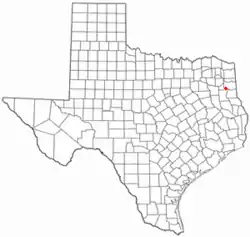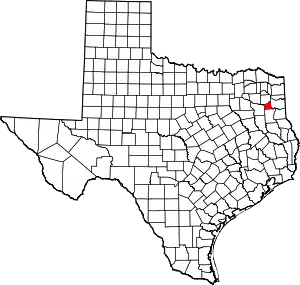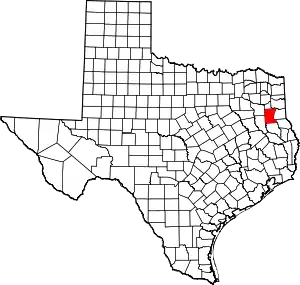Easton, Texas
Easton is a city in Gregg and Rusk counties in the U.S. state of Texas. The population was 510 at the 2010 census, and 499 at the 2020 census.[4]
Easton, Texas | |
|---|---|
 Location of Easton, Texas | |
 | |
| Coordinates: 32°23′13″N 94°35′8″W | |
| Country | |
| State | |
| Counties | Gregg, Rusk |
| Area | |
| • Total | 2.44 sq mi (6.33 km2) |
| • Land | 2.44 sq mi (6.33 km2) |
| • Water | 0.00 sq mi (0.00 km2) |
| Elevation | 272 ft (83 m) |
| Population (2020) | |
| • Total | 499 |
| • Density | 200/sq mi (79/km2) |
| Time zone | UTC-6 (Central (CST)) |
| • Summer (DST) | UTC-5 (CDT) |
| ZIP code | 75641 |
| Area code | 903 |
| FIPS code | 48-22192[2] |
| GNIS feature ID | 1356774[3] |
| Website | https://cityofeastontx.com/home |
"Easton, Texas" is the title of the fourth episode of the CBS Western television series Trackdown, starring Robert Culp as Texas Ranger Hoby Gilman. The episode aired on October 25, 1957. In the story line, a railroad official is robbed, and his head clerk played by Dabbs Greer, is mortally wounded. Townspeople mistakenly consider the clerk a hero.[5]
Easton is also briefly mentioned in the 1950s B movie The Giant Gila Monster.
Geography
Easton is located at 32°23′13″N 94°35′8″W (32.386874, –94.585589),[6] mostly in Gregg County.
According to the United States Census Bureau, the city has a total area of 2.5 square miles (6.4 km2), all land.
Demographics
| Census | Pop. | Note | %± |
|---|---|---|---|
| 1950 | 203 | — | |
| 1960 | 220 | 8.4% | |
| 1970 | 297 | 35.0% | |
| 1980 | 333 | 12.1% | |
| 1990 | 401 | 20.4% | |
| 2000 | 524 | 30.7% | |
| 2010 | 510 | −2.7% | |
| 2019 (est.) | 515 | [7] | 1.0% |
| U.S. Decennial Census[8] | |||
| Race | Number | Percentage |
|---|---|---|
| White (NH) | 59 | 11.82% |
| Black or African American (NH) | 259 | 51.9% |
| Pacific Islander (NH) | 1 | 0.2% |
| Mixed/Multi-Racial (NH) | 7 | 1.4% |
| Hispanic or Latino | 173 | 34.67% |
| Total | 499 |
As of the 2020 United States census, there were 499 people, 163 households, and 120 families residing in the city.
Education
The Gregg County portion of Easton is served by the Longview Independent School District, while the Rusk County portion is served by the Tatum Independent School District.
References
- "2019 U.S. Gazetteer Files". United States Census Bureau. Retrieved August 7, 2020.
- "U.S. Census website". United States Census Bureau. Retrieved January 31, 2008.
- "US Board on Geographic Names". United States Geological Survey. October 25, 2007. Retrieved January 31, 2008.
- "2020 Race and Population". data.census.gov. Retrieved May 20, 2022.
- "Trackdown". Classic TV Archives. Retrieved April 14, 2012.
- "US Gazetteer files: 2010, 2000, and 1990". United States Census Bureau. February 12, 2011. Retrieved April 23, 2011.
- "Population and Housing Unit Estimates". United States Census Bureau. May 24, 2020. Retrieved May 27, 2020.
- "Census of Population and Housing". Census.gov. Retrieved June 4, 2015.
- "Explore Census Data". data.census.gov. Retrieved May 20, 2022.
- http://www.census.gov
- "About the Hispanic Population and its Origin". www.census.gov. Retrieved May 18, 2022.

